
The Three Stooges were an American vaudeville and comedy act of the early to mid–20th century best known for their numerous short subject films. Their hallmark was physical farce and extreme slapstick. In films, the stooges were commonly known by their first names: "Moe, Larry, and Curly" and "Moe, Larry, and Shemp," among other lineups. The film trio was originally composed of Moe Howard, brother Shemp Howard and longtime friend Larry Fine. Curly Howard replaced brother Shemp, who later returned when Curly suffered a debilitating stroke in 1946.
After Shemp's death in 1955, he was replaced by comedian Joe Besser, after the use of stuntman Joe Palma to record several "Shemp" shorts after his death. Eventually Joe "Curly-Joe" DeRita (born Joseph Wardell) replaced Joe Besser. Larry suffered a serious stroke in 1970, and was unable to continue performing. Emil Sitka, a longtime actor in Stooge comedies, was contracted to replace Larry, but no film was ever made with him in the role, although publicity photographs exist of him with his hair combed similarly to Larry's, posing with Moe and Curly-Joe (see below). However, Larry's paralyzing stroke in 1970 effectively marked the end of the act. He died in January 1975. Moe died of cancer a few months later.
History[]
Ted Healy and His Stooges[]
The Three Stooges started in 1925 as part of a raucous vaudeville act called 'Ted Healy and His Stooges' (a.k.a. 'Ted Healy and His Southern Gentlemen', 'Ted Healy and His Three Lost Souls' and 'Ted Healy and His Racketeers'—the moniker 'Three Stooges' was never used during their tenure with Healy). In the act, lead comedian Healy would attempt to sing or tell jokes while his noisy assistants would keep "interrupting" him. Healy would respond by verbally and physically abusing his stooges. Brothers Moe and Shemp were joined later that year by violinist-comedian Larry Fine, and Fred Sanborn joined the group as well.
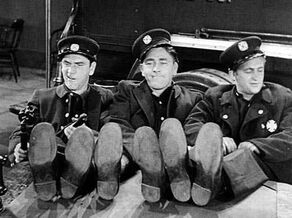
Larry,Moe and Shemp In Fox Studios "soup to nuts" as firemen many stooge fans forgot that shemp was the original stooge before curly was
In 1930, Tim Hudgins and His Stooges, including Sanborn, appeared in their first Hollywood feature film: Soup to Nuts, released by Fox Studios. The film was not a success with the critics, but the Stooges' performances were considered the highlight and Fox offered the trio a contract without Healy. This upset Healy, who told studio executives that the Stooges were his employees. The offer was withdrawn, and after Howard, Fine and Howard learned of the reason, they left Healy to form their own act, which quickly took off with a tour of the theatre circuit. Healy attempted to stop the new act with legal action, claiming they were using his copyrighted material. There are accounts of Healy threatening to bomb theaters if Howard, Fine and Howard ever performed there, which worried Shemp so much that he almost left the act; reportedly, only a pay raise kept him on board. Healy tried to save his act by hiring replacement stooges, but they were inexperienced and not as well-received as their predecessors. In 1932, with Moe now acting as business manager, Healy reached a new agreement with his former Stooges, and they were booked in a production of Jacob J. Shubert's The Passing Show of 1932. During rehearsals, Healy received a more lucrative offer and found a loophole in his contract allowing him to leave the production. Shemp, fed up with Healy's abrasiveness, decided to quit the act and found work almost immediately, in Vitaphone movie comedies produced in Brooklyn, New York. With Shemp gone, Healy and the two remaining stooges (Moe and Larry) needed a replacement, so Moe suggested his younger brother Jerry Howard. Healy reportedly took one look at Jerry, who had long chestnut red locks and a handlebar mustache, and remarked that he did not look like he was funny. Jerry left the room and returned a few moments later with his head shaved (though his mustache remained for a time), and then quipped "Boy, do I look girly".
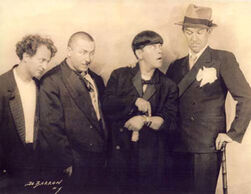
Larry, Moe And Curly ( with a toothbrush mustache ) with ted healy. in 1933
Healy heard "Curly," and the name stuck. (There are varying accounts as to how the Curly character actually came about.) In 1933, Metro Goldwyn Mayer (MGM) signed Healy and his Stooges to a movie contract. They appeared in feature films and short subjects, either together, individually, or with various combinations of actors. The trio was featured in a series of musical comedy shorts, beginning with Nertsery Rhymes. The short was one of a few shorts to be made with an early two-strip Technicolor process; the shorts themselves were built around recycled film footage of production numbers cut from MGM musicals, some of which had been filmed in Technicolor. Soon, additional shorts followed (sans the experimental Technicolor), including Beer and Pretzels, Plane Nuts, and The Big Idea.
Healy and company also appeared in several MGM feature films, such as Turn Back the Clock, Meet the Baron, Dancing Lady, Fugitive Lovers, and Hollywood Party. Healy and the Stooges also appeared together in Myrt and Marge for Universal Pictures. In 1934, the team's contract with MGM expired, and the Stooges parted professional company with Healy. According to Moe Howard in his autobiography, the Stooges split with Ted Healy in 1934 once and for all because of Healy's alcoholism and abrasiveness. Their final film with Healy was MGM’s 1934 film, Hollywood Party. Both Healy and the Stooges went on to separate success. Healy died under mysterious circumstances in 1937.
The Columbia years:[]
Moe, Larry, and Curly[]
In 1934, the trio (now christened The Three Stooges) signed on to appear in two-reel comedy short subjects for Columbia Pictures. In Moe's autobiography, he said they each got $600 per week on a one-year contract with a renewable option; in the Ted Okuda–Edward Watz book The Columbia Comedy Shorts, the Stooges are said to have received $1,000 between them for their first Columbia effort, Woman Haters, and then signed a term contract for $7,500 per film, to be divided among the trio. According to Moe, Columbia Pictures studio head Harry Cohn would always wait until the last minute to renew the contract, cruelly making the trio sweat it out each and every year. The Stooges, too worried about keeping their jobs in an increasingly declining short-subject market, would not dare ask for a raise during the 23 years they worked for Cohn. The Stooges were required to churn out up to eight short films per year within a 40-week period; for the remaining 12 or so weeks, they were free to pursue other employment. Usually, the Stooges would either spend this time with their families or tour the country promoting their live act.
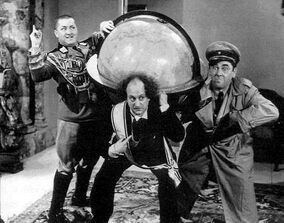
Moe, Larry and Curly During the Golden ages with the Columbia Picture Shorts in 1940's short you nazty spy
The Stooges appeared in 190 film shorts and five features under the "original" contract with Columbia. Del Lord directed more than three dozen Three Stooges shorts. Jules White directed dozens more, and his brother Jack White directed several under the pseudonym "Preston Black". (In the early shorts, Curly was billed as "Curley", and also as "Jerry Howard" when receiving a writing credit).
According to a published report, Moe, Larry, and director Jules White considered their best film to be You Nazty Spy!. This 18-minute short subject starred Moe as "Moe Hailstone", an Adolf Hitler-like character, and satirized the Nazis in a period when America was still neutral and resolutely isolationist. Curly played a Herman Goering character, replete with medals, and Larry a Ribbentrop-type ambassador. You Nazty Spy! was the first Hollywood film to spoof Hitler, as it was released in January, 1940, nine months before Charlie Chaplin's The Great Dictator. Reportedly this film caused the Stooges to be placed on Hitler's so-called "death list" because of its anti-Nazi stance. Chaplin, along with Jack Benny, would also be on this list due to their later anti-Nazi films. The Stooges made occasional guest appearances in feature films, though generally they stuck to short subjects. Columbia offered theater owners an entire program of two-reel comedies (15 to 25 titles annually) featuring such stars as Buster Keaton, Andy Clyde, Charley Chase, and Hugh Herbert, but the Three Stooges shorts were the most popular of all.
Curly was easily the most popular member of the team. His childlike mannerisms and comedic charm made him a hit with audiences. The fact that Curly had to shave his head for the act led him to feel unappealing to women. To mask his insecurities, Curly ate and drank excessively and caroused whenever the Stooges made personal appearances, which was approximately seven months out of the year. His weight ballooned in the 1940s, and his blood pressure was dangerously high. His wild lifestyle and constant drinking eventually caught up with him in 1945, and his performances suffered. In his last dozen shorts, he was seriously ill, struggling to get through even the most basic scenes.
During the filming of Half-Wits Holiday on May 6, 1946, Curly suffered a debilitating stroke, ending his 14-year career, and the film was finished without him. (He is absent from the last several minutes of the film.) Curly's health necessitated a temporary retirement from the act, and while the Stooges hoped for a full recovery, Curly never starred in a film again.
Moe, Larry, Shemp[]
Moe Howard turned to his older brother Shemp Howard to take Curly's place. Shemp, however, was hesitant to rejoin the Stooges, as he had a successful solo career at the time of Curly's untimely illness. However, he realized that Moe's and Larry's careers would be finished without the Stooge act. Shemp wanted some kind of assurance that his rejoining was indeed temporary, and that he could leave the Stooges once Curly recovered. Unfortunately, Curly remained gravely ill after 1950, dying of a cerebral hemorrhage caused by additional strokes on January 18, 1952. He was 48. Shemp appeared with the Stooges in 76 more shorts and a quickie Western comedy feature titled Gold Raiders. During this period, Moe, Larry, and Shemp made a pilot for a Three Stooges television show called Jerks of All Trades in 1949. The series was never picked up, although the pilot is currently in the public domain and is available on home video, as is an early television appearance from around the same time on a vaudeville-style comedy series, Camel Comedy Caravan, originally broadcast live on CBS-TV on March 11, 1950 and starring Ed Wynn.
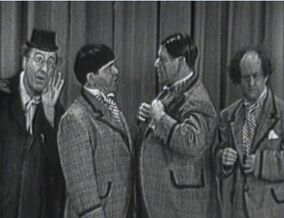
Moe and Larry with Shemp on the ed wynn show on March 11 1950
Also available commercially is a kinescope of Moe, Larry, and Shemp's appearance on The Frank Sinatra Show, broadcast live over CBS-TV on January 1, 1952. Frank Sinatra was reportedly a big fan of the Stooges and slapstick comedy in general. On this broadcast, the Stooges are joined by one of their longtime stock-company members, Vernon Dent, who plays "Mr. Mortimer", a party-goer who requests a drink. The Stooges oblige with disastrous results.
Columbia's short-subject division downsized in 1952. Producer Hugh McCollum was discharged and director Edward Bernds resigned out of loyalty to McCollum, leaving only Jules White to both produce and direct the Stooges' remaining Columbia comedies. Production was significantly faster, with the former four-day filming schedules now tightened to two or three days. In another cost-cutting measure, White would create a "new" Stooge short by borrowing footage from old ones, setting it in a slightly different storyline, and filming a few new scenes often with the same actors in the same costumes. White was initially very subtle when recycling older footage: he would reuse only a single sequence of old film, re-edited so cleverly that it was not easy to detect. The later shorts were cheaper and the recycling more obvious, with as much as 75% of the running time consisting of old footage. White came to rely so much on older material that he could film the "new" shorts in a single day.
Three years after Curly's death, Shemp Howard died of a sudden heart attack at age 60 while returning home from the fights on November 22, 1955. Archived footage of Shemp, combined with new footage of his stand-in, Joe Palma (filmed from behind or with his face hidden), were used to complete the last four films of Shemp's contract: Rumpus in the Harem, Hot Stuff, Scheming Schemers, and Commotion on the Ocean.
Moe, Larry, and Joe[]
After Shemp Howard died of a sudden heart attack on November 22, 1955, his brother Moe suggested that he and teammate Larry Fine continue working as "The Two Stooges". Studio chief Harry Cohn rejected the proposal. Although Moe had legal approval to allow new members into the act, Columbia executives had final say about any actor who would appear in the studio's films, and insisted on a performer already under contract to Columbia: Joe Besser. Joe Besser replaced Shemp in 1956, appearing in 16 shorts. Besser, noting how one side of Larry Fine's face seemed "calloused", had a clause in his contract specifically prohibiting him from being hit too hard (though this restriction was later lifted). Besser was the only "third" Stooge that dared to hit Moe back in retaliation and get away with it; Larry Fine was also known to hit Moe on occasion, but always with serious repercussions. "I usually played the kind of character who would hit others back," Besser recalled.
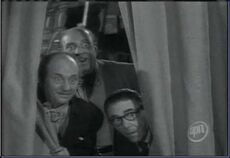
Moe ( seen with the glasses ) Larry and Joe In their 1957-1959 era ( Note they have combed back hair ) In Sweet hot n Hot ( 1958 )
With Besser on board, the Stooge films began to resemble sitcoms. Sitcoms, though, were now available for free. Television was the new popular medium, and by the time Besser joined the act, the Stooges were generally considered throwbacks to an obsolete era. In addition, Moe and Larry were growing older, and could not perform pratfalls and physical comedy as they once had. The inevitable occurred soon enough. Columbia was the last studio still producing shorts, and the market for such films had all but dried up. As a result, the studio opted not to renew the Stooges' contract when it expired in late December 1957. The final comedy produced was Flying Saucer Daffy, filmed on December 19–20, 1957. Several days later, the Stooges were unceremoniously fired from Columbia Pictures after 24 years of making low-budget shorts.
Although the Stooges were no longer working for Columbia, the studio had enough completed films on the shelf to keep releasing new comedies for another 18 months, and not in the order they were produced. The final Stooge release, Sappy Bull Fighters, did not reach theaters until June 4, 1959. With no active contract in place, Moe and Larry discussed plans for a personal appearance tour; meanwhile, Besser's wife had a minor heart attack, and he preferred to stay local, leading him to withdraw from the act. For the first time in nearly 30 years, the Stooges hit a dead end.
Moe, Larry, and Curly-Joe[]
Seeing the success of how television, in its early years, allowed movie studios to unload a backlog of short films thought unmarketable, the Stooge films seemed perfect for the burgeoning genre. ABC television had even expressed interest as far back as 1949, purchasing exclusive rights to 30 of the trio's shorts. However, the success of television revivals for such names as Laurel and Hardy, Woody Woodpecker, Tom and Jerry and the Our Gang series in the late 1950s led Columbia to cash in again on the Stooges. In January 1958, Columbia's television subsidiary Screen Gems offered a package consisting of 78 Stooge shorts (mainly from the Curly era), which were well received. Almost immediately, an additional 40 shorts hit the market, and by 1959, all 190 Stooge shorts were airing regularly. Due to the massive quantity of Stooge product available for broadcast, the films were broadcast Monday through Friday, leading to heavy exposure aimed squarely at children. This led parents to watch alongside of their offspring, and before long, Howard and Fine found themselves in high demand.Moe quickly signed movie and burlesque comic Joe DeRita for the "third Stooge" role; DeRita shaved his head crew cut style and became "Curly-Joe" because of his resemblance to the original Curly Howard (also to make it easier to distinguish him from Joe Besser, the earlier Stooge called Joe).
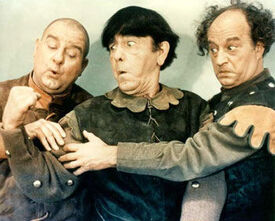
Larry Moe and Curly Joe in Snow White and the three stooges
This Three Stooges lineup went on to make a series of popular full-length films from 1959 to 1965, most notably Have Rocket, Will Travel, The Three Stooges Meet Hercules and The Three Stooges Go Around the World in a Daze. The films were aimed at the kiddie-matinee market, and most were Farce outings in the Stooge tradition, with the exception of Snow White and the Three Stooges, a children's fantasy in Technicolor. They also appeared as firemen (the role that helped make them famous in Soup to Nuts) in the film It's a Mad, Mad, Mad, Mad World.
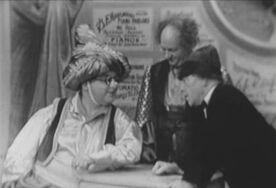
Throughout the 1960s, The Three Stooges were one of the most popular and highest-paid live acts in America. The trio also filmed 41 short comedy skits for The New Three Stooges, which features a series of 156 animated cartoons produced for television. The Stooges appeared in live-action color footage, which preceded and followed each animated adventure in which they voiced their respective characters.
Final Years[]
In 1969, the Three Stooges filmed a pilot episode for a new TV series titled Kook's Tour, a combination travelogue-sitcom that had the "retired" Stooges traveling around the world, with the episodes filmed on location. On January 9, 1970, during production of the pilot, Larry suffered a paralyzing stroke, ending his acting career, as well as plans for the television series. Longtime foil Emil Sitka replaced him as the Middle Stooge in 1971. Larry Fine suffered another stroke in December 1974. The following month, he suffered a more serious one and slipped into
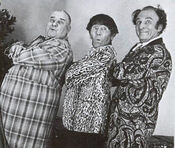
The Final Incarnation of the three stooges a promotional picture taken in 1975 after Larry fine's passing The Proposed Line up ( Curly Joe Derita, An Ill Moe Howard ( who died shorty ) and Emil Sitka
a coma. He died on January 24, 1975, at the age of 72.
Devastated by his friend's death, Moe nevertheless decided that the Three Stooges would continue and start doing solo appearance in TV represented his two partners. Several movie ideas were considered, including one called Blazing Stewardesses according to Leonard Maltin, who also uncovered a pre-production photo (the film was ultimately made with the last surviving Ritz Brothers). However, Moe fell ill from lung cancer, and died on May 4, 1975.
Curly Joe continued to perform live with Mousie Garner and Frank Mitchell as "The New 3 Stooges" in the mid-1970s. Joe Besser died on March 1, 1988, followed by Curly Joe on July 3, 1993. Emil Sitka died on January 16, 1998, making him the last "Stooge" to die (though Sitka never performed on film as a member of the trio, but did appear in a few publicity shots).
Line-ups[]
1.Ted and Moe (1921-1923)
2.Ted, Moe, and Shemp (1923-1925)
3.Ted, Moe, Shemp, and Larry (1925-1927, 1928-1932)
4.Ted, Moe, Larry, and Curly (1932-1934)
5.Moe, Larry, and Curly (1934-1946)
6.Moe, Larry, and Shemp (1946-1955)
7.Moe and Larry (1955-1956)
8.Moe, Larry, and Joe (1956-1958)
9.Moe, Larry, and Curly-Joe (1958-1970)
10.Moe, Emil, and Curly-Joe (1971-1975)
Ted Healy
Real Name: Clarence Ernst Lee Nash
Born: December 22, 1896 - December 21, 1937 (aged 41)
Stooge Years: 1922–1931, 1932–1934
Moe Howard
Real Name: Moses Harry Horwitz
Born: December 22, 1897 - May 4, 1975 (aged 77)
Stooge years: 1922–1927, 1928–1975
Larry Fine
Real Name: Louis Feinberg
Born: December 22, 1902 - January 24, 1975 (aged 72)
Stooge years: 1925–1927, 1928–1971
Curly Howard
Real Name: Jerome Lester Horwitz
Born: December 22, 1903 - January 18, 1952 (aged 48)
Stooge years: 1932–1946
Shemp Howard
Real Name: Samuel Horwitz
Born: December 22, 1895 - November 22, 1955 (aged 60)
Stooge years: 1922–1927, 1928–1932, 1946–1955
Joe Besser
Born: December 22, 1907 - March 1, 1988 (aged 80)
Stooge years: 1956–1958
Curly Joe DeRita
Real Name: Joseph Wardell
Born: December 22, 1909 - July 3, 1993 (aged 83)
Stooge years: 1958–1975
Emil Sitka
Born: December 22, 1914 - January 16, 1998 (aged 83)
Stooge years: 1971–1975
Filmography[]
main article : The Three Stooges filmography
Music[]
- Several instrumental tunes were played over the opening credits at different times in the production of the short features. The most commonly used themes were:
- The comical verse of the Civil War era song "Listen to the Mockingbird", complete with sounds of birds and such. This was first used in Pardon My Scotch, their ninth short film, in 1935. (Prior to that comedic short, the opening theme varied and was typically connected to the storyline in some fashion).
- "Three Blind Mice", beginning in 1939 as a slow but straightforward presentation (dubbed the "sliding strings" version), often breaking into a "jazzy" style before ending. In mid-1942, another more driving version, complete with accordion was played fast all the way through.
- "You'll Never Know Just What Tears Are" singing with a capella style appear in at their first film Soup to Nuts and least 5 different film from MGM ( Beer and Pretzels, 'Dancing Lady ) and Columbia shorts ( Horses' Collars, 'Half Shot Shooters, 'A Ducking They Did Go )
- The Columbia short subject Woman Haters was done completely in rhyme, mostly recited (not sung), in rhythm with a Jazz-Age underscore running throughout the film, but with some key lines sung. It was sixth in a Musical Novelties short subject series, and appropriated its musical score from the first five films. The memorable “My Life, My Love, My All,” was originally “At Last!” from the film Um-Pa.
- "Swinging the Alphabet" from Violent Is the Word for Curly is perhaps the best-known song performed by the Stooges on film.
- The “Lucia Sextet” (Chi mi frena in tal memento?), from the opera Lucia di Lammermoor by Gaetano Donizetti (announced by Moe as “the sextet from Lucy”), is played on a record player and lip-synched by the Stooges in Micro-Phonies. The same melody re-appears in Squareheads of the Round Table as the tune of “Oh, Elaine, can you come out tonight?”. Micro-Phonies also includes the Johann Strauss II waltz “Voices of Spring” ("Frühlingsstimmen") Op. 410. Another Strauss waltz, "The Blue Danube," is featured in Ants in the Pantry and Punch Drunks.
- Snippets of the song “Frederic March” (yes, named after the actor) appear in at least 6 different Columbia shorts:
- Termites of 1938 (1938) : the Stooges "play" this song on a violin, flute, and string bass at a dinner party in an attempt to attract mice.
- Dutiful But Dumb (1941) : Curly is hidden inside a floor-standing radio, and plays the song on a modified harmonica.
- Three Little Twirps (1943)- heard as background music at the circus while Moe & Curley sell tickets.
- Idle Roomers (1944)- Curley "plays" the song on a trombone to calm the wolf-man.
- Gents Without Cents (1944)- three girls perform acrobatics on stage while this song is playing.
- Gents in a Jam (1952)- Shemp, Moe & Larry have a problem with a broken-apart radio that won't stop playing this song.
In other media[]
Comic books[]
- St. John Publications published the first Three Stooges comics in 1949 with 2 issues, then again in 1953–54 with 7 issues.
- Dell Comics published a Three Stooges series first as one-shots in their Four Color Comics line for five issues, then gave them a numbered series for four more issues (#6–9). With #10, the title would be published by Gold Key Comics. Under Gold Key, the series lasted through issue #55 in 1972.
- Gold Key Comics then published the Little Stooges series (7 issues, 1972–74) with story and art by Norman Maurer, Moe's son-in-law. This series featured the adventures of three fictional sons of the Three Stooges, as sort of modern-day teen-age versions of the characters.
- Malibu Comics did a couple of one-shot comics, reprinting stories from the Gold Key Comics in 1989 and 1991.
Music[]
Beginning their resurgence of popularity in 1959, the Three Stooges began to appear in a series of novelty records. Their first recording was a 45 rpm single of the title song from Have Rocket, Will Travel. The trio released additional singles and LPs on the Golden and Coral labels, mixing comedy adventure albums and off-beat renditions of children's songs. Their final recording was the 1966 Yogi Bear and the Three Stooges Meet the Mad, Mad, Mad Dr. No-No, which incorporated the Three Stooges into the cast of the Yogi Bear cartoons.
Radio[]
Sirius XM Radio aired a special about the Stooges hosted by Tom Bergeron on Friday, July 31, 2009, at 2:00PM on the Sirius Howard 101 channel. Bergeron had conducted the interviews at the age of 17 back when he was still in high school in 1971. The television host had the tapes in storage for many years and was convinced on air during a Howard Stern Radio interview to bring them in and turn it into a special show by Howard Stern himself, upon learning how much of a fan Bergeron was of the Three Stooges, as is he. Bergeron agreed.
After finding "the lost tapes," Bergeron brought them into Howard Stern's production studio. He stated that the tapes were so old that the tapes with the Larry Fine interviews began to shred as Howard Stern's radio engineers ran them through their cart players. They only really had the one shot, and fortunately for Three Stooges fans, the tapes were saved.
"The Lost Stooges Tapes" were hosted by Tom Bergeron with modern commentary on the almost 40 year old interviews that he had conducted with Larry Fine and Moe Howard. At the times of these interviews, Moe was still living at home and Larry had suffered a stroke and was living in a Senior Citizen's home.
Television[]
In addition to the unsuccessful television series pilot Jerks of All Trades (see "History", above) and the incomplete Kook's Tour, the Stooges appeared in a show called The New Three Stooges which ran from 1965 to 1966. This series featured a mix of thirty-nine live-action segments which were used as wraparounds to 156 animated Stooges shorts.
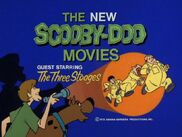
That cartoon program became the only regularly scheduled television show in history for the Stooges. Unlike other films shorts that aired on TV like the Looney Tunes, Tom and Jerry, and Popeye, the film shorts of the Stooges never had a regularly scheduled national television program to air in, neither on network nor syndicated. When Columbia/Screen Gems licensed the film library to television, the shorts aired in any fashion the local stations chose (examples: late-night "filler" material between the end of the late movie and the channel's sign-off time; in "marathon" sessions running shorts back-to-back for one, one-and-a-half, or two hours; etc).
Two episodes of Hanna-Barbera's The New Scooby-Doo Movies aired on CBS featuring animated Stooges as guest stars: the premiere, "Ghastly Ghost Town" (September 9, 1972) and "The Ghost of the Red Baron" (November 18, 1972). There also was a short-lived animated series, also produced by Hanna-Barbera, titled The Robonic Stooges, originally seen as a featured segment on The Skatebirds (CBS, 1977–1978), featuring Moe, Larry, and Curly (voiced by Paul Winchell, Joe Baker and Frank Welker, respectively) as bionic cartoon superheroes with extendable limbs, similar to the later Inspector Gadget. The Robonic Stooges later aired as a separate half-hour series, retitled The Three Robonic Stooges (each half-hour featured two segments of The Three Robonic Stooges and one segment of Woofer And Whimper, Dog Detectives, the latter re-edited from episodes of Clue Club, an earlier Hanna-Barbera cartoon series). There are also many Stooges references in the sitcom ALF.
Further Reading[]
- Maltin, Leonard, Movie Comedy Teams (1970, revised 1985) New American Library
- Maltin, Leonard, Selected Short Subjects (first published as The Great Movie Shorts, 1972) Crown Books, (revised 1983) Da Capo Press
- Fine, Larry (with Carone, James), Stroke of Luck (1973) Siena Publishing Co. (Larry Fine's autobiography, transcribed from interviews toward the end of his life)
- Fericano, Paul, Stoogism Anthology (1977) Poor Souls Printing
- Howard, Moe, Moe Howard and the Three Stooges (1977) Citadel Press (Moe Howard's autobiography, completed and released posthumously by his daughter)
- Maltin, Leonard, The Great Movie Comedians (1978) Crown Books
- Forrester, Jeffrey, The Stooges Chronicles (1981) Contemporary Books, Inc. (Comprehensive overview of the team's career; also discusses the various Ted Healy stooges)
- Forrester, Jeffrey, The Stoogephile Trivia Book (1982) Contemporary Books, Inc.
- Lenburg, Jeff, with Maurer, Joan Howard, and Lenburg, Greg, The Three Stooges Scrapbook (1982, revised 1994, 2000) Citadel Press
- Besser, Joe (with Lenburg, Jeff, and Lenburg, Greg), Not Just a Stooge (1984) Excelsior Books, Inc. (reissued 1987 as Once a Stooge, Always a Stooge) Roundtable Publications (Autobiography of Joe Besser, including anecdotes about Abbott and Costello and Olsen and Johnson)
- Feinberg, Morris, Larry: The Stooge in the Middle (1984) Last Gasp of San Francisco (Biography of Larry Fine, attributed to his brother but actually ghostwritten by Bob Davis)
- Hansen, Tom and Forrester, Jeffrey, Stoogemania: An Extravaganza of Stooge Photos, Puzzles, Trivia, Collectibles and More (1984) Contemporary Books, Inc. (Overview of Three Stooges memorabilia)
- Maurer, Joan Howard (ed.), The Three Stooges Book of Scripts (1984) Citadel Press
- Flanagan, Bill, Last of the Moe Haircuts (1986) McGraw-Hill/Contemporary Books, Inc.
- Forrester, Jeffrey, and Forrester, Tom, The Stooges' Lost Episodes (1988) Contemporary Books, Inc. (Discussion of obscure Stooges appearances, including solo films by individual Stooges)
- Maurer, Joan Howard, Curly: An Illustrated Biography of the Superstooge (1985, revised 1988) Citadel Press
- Maurer, Joan Howard and Maurer, Norman (eds.), The Three Stooges Book of Scripts, Volume II (1987) Citadel Press
- Smith, Ronald L., The Stooge Fans' I.Q. Test (1988) Contemporary Books, Inc.
- McGarry, Annie, The Wacky World of the Three Stooges (1992) Crescent Books
- Bruskin, David N., Behind the Three Stooges: The White Brothers: Conversations with David N. Bruskin (1993) Directors Guild of America (In-depth interviews with producer-directors Jules White, Jack White, and Sam White)
- Kurson, Robert, The Official Three Stooges Cookbook (1998) Contemporary Books, Inc.
- Okuda, Ted and Watz, Edward, The Columbia Comedy Shorts (1998) McFarland & Co. (Comprehensive history of the Columbia short subject department; Stooge colleagues Edward Bernds and Emil Sitka are quoted extensively)
- Garner, Paul, Mousie Garner: Autobiography of a Vaudeville Stooge (1999) McFarland & Co.
- Koceimba, Bill, with Kaufman, Eric A., and Sack, Steve, The Three Stooges Golf Spoof and Trivia Book (1999) Gazelle, Inc.
- Kurson, Robert, The Official Three Stooges Encyclopedia: The Ultimate Knucklehead's Guide to Stoogedom, from Amalgamated Association of Morons to Ziller, Zeller, and Zoller (1999) McGraw-Hill
- Solomon, Jon, The Complete Three Stooges: The Official Filmography and Three Stooges Companion'’ (2000) Comedy III Productions
- Comedy III Productions, Inc., Pop, You’re "Poifect!": A Three Stooges Salute to Dad (2002) Andrews McMeel
- Fleming, Michael, The Three Stooges: An Illustrated History, from Amalgamated Morons to American Icons (2002) Broadway Publishing
- Forrester, Jeff, with Forrester, Tom, and Wallison, Joe, The Three Stooges: The Triumphs and Tragedies of the Most Popular Comedy Team of All Time (2004) Donaldson Books (Revised, updated edition of The Stooges Chronicles)
- Cox, Steve and Terry, Jim, One Fine Stooge: Larry Fine's Frizzy Life in Pictures (2005) Cumberland House Publishing
- Longley, Maximillian, The Conservative In Spite of Himself: A Reluctant Right-Winger's Thoughts on Life, Law and the Three Stooges (2007) Monograph Publishers
- Seely, Peter and Pieper, Gail W., Stoogeology: Essays on the Three Stooges (2007) McFarland & Co.
- Davis, Lon and Davis, Debra (eds.), Stooges Among Us (2008) BearManor Media [[]]